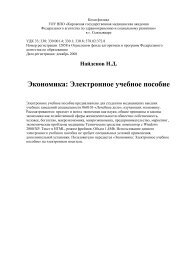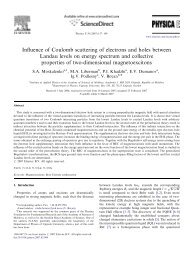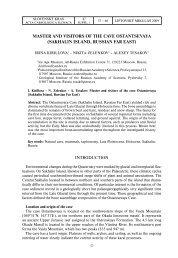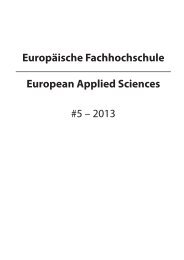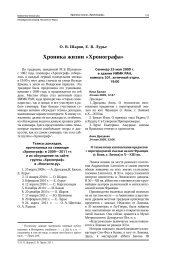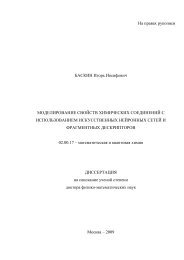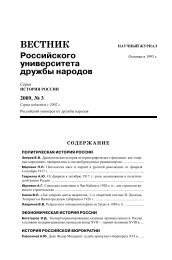ÐÐ ÐÐЦÐÐ ÐÐ ÐÐÐÐЬÐЫХ ÐÐÐÐЩÐÐÐÐ: меÑодологиÑ, задаÑи ...
ÐÐ ÐÐЦÐÐ ÐÐ ÐÐÐÐЬÐЫХ ÐÐÐÐЩÐÐÐÐ: меÑодологиÑ, задаÑи ...
ÐÐ ÐÐЦÐÐ ÐÐ ÐÐÐÐЬÐЫХ ÐÐÐÐЩÐÐÐÐ: меÑодологиÑ, задаÑи ...
You also want an ePaper? Increase the reach of your titles
YUMPU automatically turns print PDFs into web optimized ePapers that Google loves.
381<br />
CONTENTS<br />
Preface 3<br />
List of Abbreviations 6<br />
Chapter 1. Physical and phenomenological description of reality 7<br />
1.1 Micro- and macrolevel of reality 7<br />
1.2 Cognitive stability and instability 10<br />
1.3 Cognitive Self-Organized Criticality 14<br />
1.4 Semantic reality. Limiting meanings 19<br />
1.5 Tests, systemopatterrns, and systemoquanta 22<br />
1.6 Principles of cognitive paradigm 24<br />
Chapter 2. Elementary tests. Domain digraphs 28<br />
2.1 Basic definitions 28<br />
2.2 Canonical presentation of a domain digraph 47<br />
2.3 Closure, upper and lower bounds of a data set 51<br />
2.4 Descending determination. Suboptimization 59<br />
2.5 Entropy characteristics of domain digraphs 71<br />
2.6 Test protostructure maturation 82<br />
Chapter 3. Real-world situation description model 86<br />
3.1 Test properties. Lexis. Test implementation mechanisms 86<br />
3.2 Test “Time”. Events 94<br />
3.3 Structures and their properties 99<br />
3.4 Situation sketches 105<br />
3.5 Situation development model. Impulses. Situation description 112<br />
3.6 Information sets. Generalization sets 118<br />
3.7 Similarity of real-world situations 124<br />
Chapter 4. Test configurators 132<br />
4.1 Definition of a configurator. Examples 132<br />
4.2 Domain and configurator formation methods 134<br />
4.3 “Bar-code” quantization method 172<br />
4.4 Spreadsheet implementation of a precedent and configurator base 184<br />
Chapter 5. Method of limiting generalizations 187<br />
5.1 Probabilistic regularities, formal syndromes, syndromic and<br />
probabilistic knowledge models 187<br />
5.2 Application of syndromic and probabilistic knowledge models 218<br />
5.3 Critical descriptions of a precedent base. Syndromic knowledge<br />
models for critical descriptions 224<br />
5.4 Dual syndromic knowledge models 231<br />
5.5 Analysis of formal notions, biclusterization, and cognitive approach 235<br />
5.6 Example: assessment and prediction of a clinical course 248



